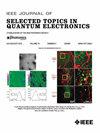Tunable Switching of Quasi-Bound States in the Continuum in Terahertz Metasurfaces
IF 5.1
2区 工程技术
Q1 ENGINEERING, ELECTRICAL & ELECTRONIC
IEEE Journal of Selected Topics in Quantum Electronics
Pub Date : 2025-10-08
DOI:10.1109/JSTQE.2025.3619128
引用次数: 0
Abstract
Bound states in the continuum (BIC) are a special type of optical resonance with strong field confinement and minimal energy loss, making them highly attractive for photonics applications. In this work, we propose a terahertz metasurface capable of supporting both symmetry-protected BIC and quasi-BIC (q-BIC) resonances. By intentionally breaking the structural symmetry, the optical response transitions from a symmetry-protected BIC to a leaky q-BIC resonance, enabling strong light-matter interaction. Especially, integrating the phase-change material vanadium dioxide (VO2) enables reversible, thermally driven switching between BIC and q-BIC modes via its insulator-to-metal transition. Meanwhile, a maximum modulation depth of 96% can be achieved by tuning the conductivity of VO2. Furthermore, the high quality-factor (Q-factor) of the q-BIC mode endows the hybrid metal-VO2 metasurface with remarkable sensing capabilities, achieving a sensitivity of 3708 GHz/RIU. This study advances the design of tunable terahertz devices, offering insights for dynamic modulators, switches, and high-performance sensors in the terahertz frequency range.太赫兹超表面连续介质中准束缚态的可调谐开关
连续介质中的束缚态(BIC)是一种特殊类型的光学共振,具有强的场约束和最小的能量损失,使其在光子学应用中具有很高的吸引力。在这项工作中,我们提出了一种能够支持对称保护BIC和准BIC (q-BIC)共振的太赫兹超表面。通过故意破坏结构对称性,光学响应从对称保护的BIC转变为泄漏的q-BIC共振,从而实现强光-物质相互作用。特别是,集成相变材料二氧化钒(VO2)可以通过其绝缘体到金属的转变在BIC和q-BIC模式之间实现可逆的热驱动切换。同时,通过调节VO2的电导率,可以实现96%的最大调制深度。此外,q-BIC模式的高质量因子(Q-factor)赋予了混合金属- vo2元表面显著的传感能力,实现了3708 GHz/RIU的灵敏度。这项研究推进了可调谐太赫兹器件的设计,为太赫兹频率范围内的动态调制器、开关和高性能传感器提供了见解。
本文章由计算机程序翻译,如有差异,请以英文原文为准。
求助全文
约1分钟内获得全文
求助全文
来源期刊

IEEE Journal of Selected Topics in Quantum Electronics
工程技术-工程:电子与电气
CiteScore
10.60
自引率
2.00%
发文量
212
审稿时长
3 months
期刊介绍:
Papers published in the IEEE Journal of Selected Topics in Quantum Electronics fall within the broad field of science and technology of quantum electronics of a device, subsystem, or system-oriented nature. Each issue is devoted to a specific topic within this broad spectrum. Announcements of the topical areas planned for future issues, along with deadlines for receipt of manuscripts, are published in this Journal and in the IEEE Journal of Quantum Electronics. Generally, the scope of manuscripts appropriate to this Journal is the same as that for the IEEE Journal of Quantum Electronics. Manuscripts are published that report original theoretical and/or experimental research results that advance the scientific and technological base of quantum electronics devices, systems, or applications. The Journal is dedicated toward publishing research results that advance the state of the art or add to the understanding of the generation, amplification, modulation, detection, waveguiding, or propagation characteristics of coherent electromagnetic radiation having sub-millimeter and shorter wavelengths. In order to be suitable for publication in this Journal, the content of manuscripts concerned with subject-related research must have a potential impact on advancing the technological base of quantum electronic devices, systems, and/or applications. Potential authors of subject-related research have the responsibility of pointing out this potential impact. System-oriented manuscripts must be concerned with systems that perform a function previously unavailable or that outperform previously established systems that did not use quantum electronic components or concepts. Tutorial and review papers are by invitation only.
 求助内容:
求助内容: 应助结果提醒方式:
应助结果提醒方式:


